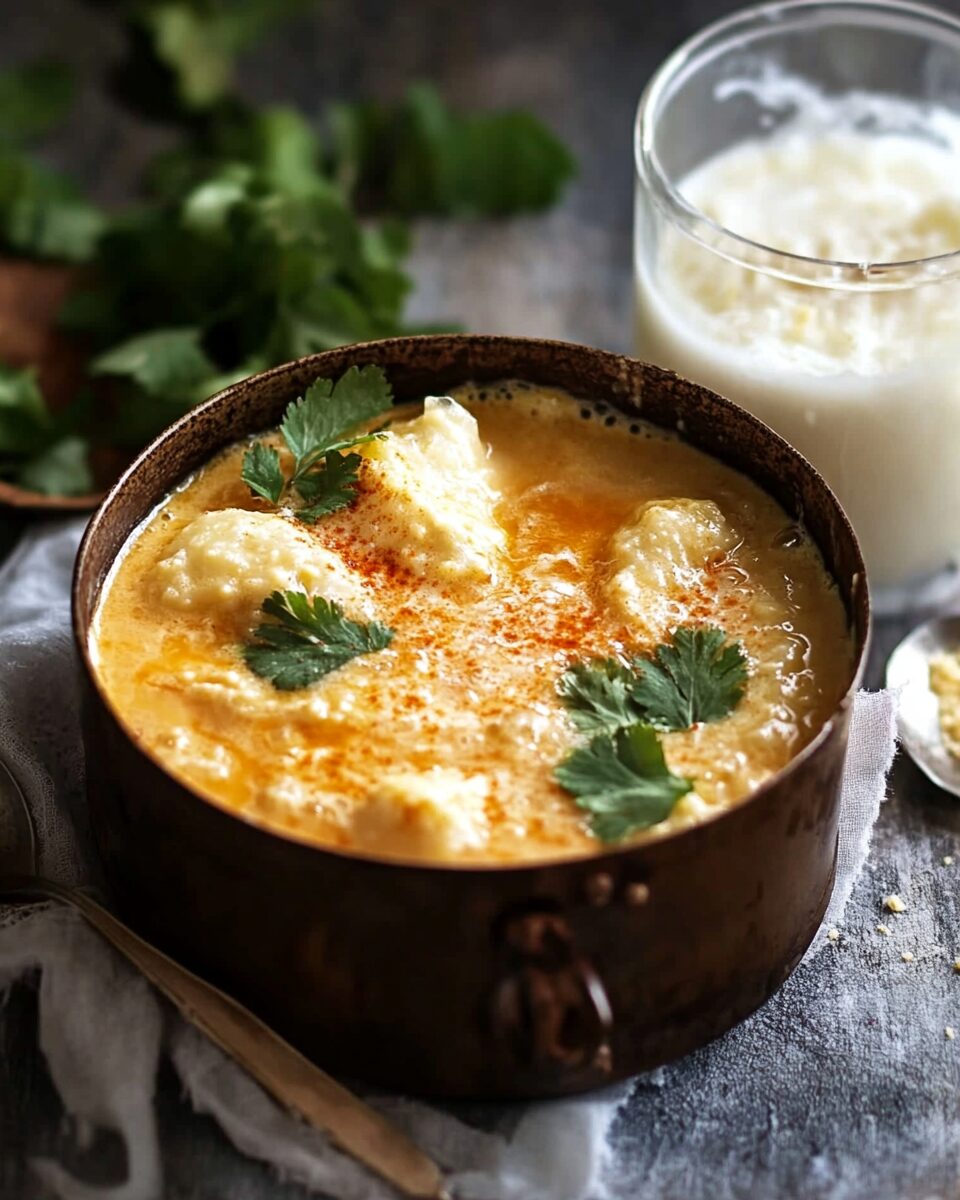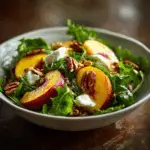A rich and flavorful chicken curry, East African Kuku Paka combines coastal Swahili and Indian influences into a creamy, coconut-based dish. Marinated and grilled chicken is simmered in a fragrant sauce of coconut milk, spices, and tomatoes for a comforting, mildly spiced meal that’s perfect with rice or flatbread.
FULL RECIPE
Ingredients
- 1 whole chicken (cut into pieces) or 2 lbs bone-in chicken thighs/drumsticks
- 1 cup plain yogurt
- 1 teaspoon ground turmeric
- 1 teaspoon ground cumin
- 1 teaspoon paprika
- 1 teaspoon salt
- 1 tablespoon lemon juice
- 2 tablespoons oil (for grilling/frying)
- 1 large onion, finely chopped
- 3 garlic cloves, minced
- 1 tablespoon ginger, grated
- 2 large tomatoes, chopped
- 1 teaspoon ground coriander
- 1/2 teaspoon chili powder (adjust to taste)
- 1 can (13.5 oz) coconut milk
- 1/2 cup water (as needed)
- Fresh cilantro for garnish
Directions
- In a large bowl, mix yogurt, turmeric, cumin, paprika, salt, and lemon juice. Add chicken pieces and coat well. Marinate for at least 1 hour (overnight for best flavor).
- Grill or pan-fry the marinated chicken until browned and partially cooked. Set aside.
- In a large pan, heat 2 tablespoons oil. Sauté onions until golden.
- Add garlic and ginger; cook for 1–2 minutes until fragrant.
- Stir in chopped tomatoes, coriander, and chili powder. Cook until tomatoes break down and the mixture thickens.
- Pour in coconut milk and mix well. Add 1/2 cup water if sauce is too thick.
- Add grilled chicken to the sauce. Cover and simmer for 20–25 minutes until chicken is fully cooked and tender.
- Garnish with chopped cilantro and serve hot with rice or chapati.
Nutritional Information
- Calories: 420
- Protein: 28g
- Fat: 28g
- Carbohydrates: 12g
- Fiber: 2g
- Sugar: 4g
- Sodium: 580mg
Cultural Significance of Kuku Paka
Kuku Paka is more than just a delicious meal—it represents a culinary bridge between cultures, particularly between East Africa and South Asia. Popular in countries like Kenya, Tanzania, and Uganda, the dish is a result of the coastal Swahili people’s interactions with Arab, Indian, and Portuguese traders over centuries. The fusion of ingredients and spices reflects the shared history and diverse influence that shaped East African cuisine.
Swahili Culinary Influence
The Swahili coast, running along the Indian Ocean, is known for its unique cooking style. Dishes from this region frequently incorporate coconut, spices, and seafood. Kuku Paka embodies this tradition with its use of coconut milk, grilled meat, and aromatic spices, making it an authentic representation of Swahili fusion cuisine.
Indian and Arabic Roots
Indian settlers and traders brought spices, cooking techniques, and ingredients like cumin, coriander, and chili to East Africa. The word “paka,” which refers to the coconut-based sauce, is thought to have Indian linguistic origins. The blend of Indian-style marination with coconut milk curry mirrors the influence of Indian coastal cuisine.
Common Variations of the Dish
Kuku Paka can vary from one household to another. Some versions are more tomato-forward, while others emphasize the creaminess of the coconut milk. It can be made with boneless chicken, grilled or fried chicken, and even with seafood like prawns or fish. Some recipes also include boiled eggs, potatoes, or a touch of tamarind for added tanginess.
Traditional Cooking Techniques
Traditionally, Kuku Paka involves marinating the chicken in spices and yogurt before grilling over open flame or charcoal, which imparts a smoky flavor. In rural or coastal homes, this is done over wood fires, giving it a rustic and authentic taste. The sauce is usually slow-cooked to allow the flavors to meld properly.
Modern Adaptations
In modern kitchens, many cooks simplify the process by pan-frying the chicken or using boneless pieces for faster cooking. Some also use canned coconut milk for convenience, and substitute fresh ground spices with ready-made curry powders. Despite these adaptations, the essence of Kuku Paka remains intact.
Serving Suggestions
Kuku Paka is often served with rice, especially fragrant basmati or pilau rice. It also pairs well with flatbreads like chapati or naan. On the coast, it’s common to see it served with ugali, a stiff maize porridge, or viazi vya rojo, which are potatoes in tomato sauce.
Spice Profile and Flavor Notes
The flavor profile of Kuku Paka is mild to moderately spicy, with warm notes from cumin and coriander, subtle heat from chili, and richness from the coconut milk. The grilled chicken adds a slightly smoky depth, and the fresh herbs brighten the dish. The balance of creamy, spicy, and tangy elements is key.
Texture and Consistency
The sauce of Kuku Paka is typically smooth and moderately thick. It should coat the chicken well but still be pourable over rice or bread. The chicken should be tender, having absorbed both the marinade and the curry sauce flavors. Some people enjoy a chunkier version with pieces of tomato or onion left whole.
Health and Nutrition Aspects
Kuku Paka offers a good balance of protein and healthy fats, particularly when using coconut milk in moderation. It’s gluten-free and can be made dairy-free by omitting the yogurt or using plant-based alternatives. Lean cuts of chicken can help reduce saturated fat, and serving with vegetables boosts its nutritional value.
Popular in Coastal Celebrations
On the Kenyan and Tanzanian coasts, Kuku Paka is a popular choice for special occasions and family gatherings. It’s often part of festive meals during Ramadan, weddings, or communal feasts. The dish’s aroma and richness make it ideal for serving a crowd.
Pairing with Beverages
Due to its creamy and spiced nature, Kuku Paka pairs well with cooling drinks such as mango lassi, tamarind juice, or fresh coconut water. These beverages help balance the spices and enhance the dining experience, particularly in hot climates.
Global Appeal and Diaspora Influence
East African diaspora communities around the world have introduced Kuku Paka to new audiences. It has gained popularity in cities with large African or Indian populations and is often featured in African fusion restaurants. Its universal appeal lies in the familiar comfort of curry combined with grilled meat.
Fusion and Experimental Twists
Some chefs have created modern takes on Kuku Paka by incorporating it into tacos, pasta, or wraps. Others experiment with using it as a pizza topping or combining it with different meats like lamb or tofu for vegetarian versions. This flexibility shows how adaptable and inspiring the base flavors of Kuku Paka can be.
Cooking Tips for Best Results
Marinating the chicken for several hours is crucial for deep flavor. Using fresh garlic, ginger, and spices enhances the authenticity of the dish. Allowing the sauce to simmer slowly and using good-quality coconut milk ensures a silky texture and full flavor. Finishing with fresh herbs like cilantro elevates the dish.
Storage and Reheating
Kuku Paka stores well in the refrigerator for up to three days. The flavors often deepen overnight, making it even more delicious the next day. Reheat gently on the stove, adding a splash of water or coconut milk if the sauce thickens too much. It can also be frozen for up to one month.
Culinary Storytelling Through Food
Every family’s Kuku Paka recipe has a story—passed down through generations, adapted through migration, or tweaked based on local ingredients. Sharing this dish connects people not only through taste but through memory and heritage. It’s a testament to how food preserves identity and history.
Common Mistakes to Avoid
One common mistake is rushing the cooking process. Skipping the marinade or not simmering the sauce long enough can result in blandness. Overcooking the chicken can make it dry. Also, using low-fat coconut milk or poor-quality substitutes can compromise the rich texture and flavor of the dish.
Kid-Friendly Version
For a milder version suitable for children, reduce the chili or omit it altogether. Using boneless chicken makes it easier to eat, and serving it with plain rice or flatbread helps tone down the spices. You can also blend the sauce for a smoother texture if desired.
Conclusion
Kuku Paka is a dish that beautifully captures the essence of East African coastal cuisine, enriched by Indian and Arabic culinary traditions. Its comforting flavors, creamy sauce, and smoky grilled chicken make it a favorite in many households. Whether served during a family gathering or as a weeknight dinner, it continues to bring people together around the table. With its versatility and depth of flavor, Kuku Paka is not just a meal—it’s a story of migration, adaptation, and cultural fusion expressed through food.






